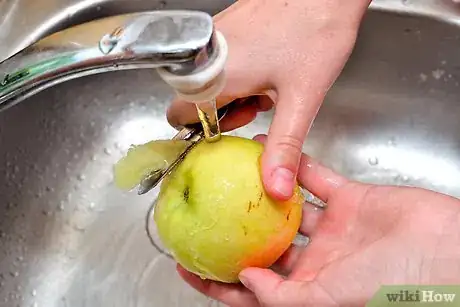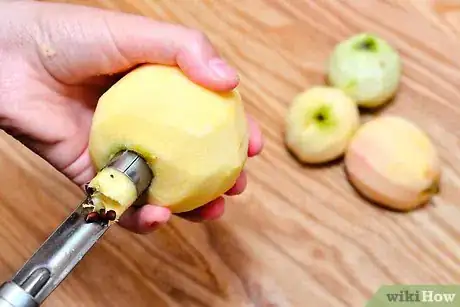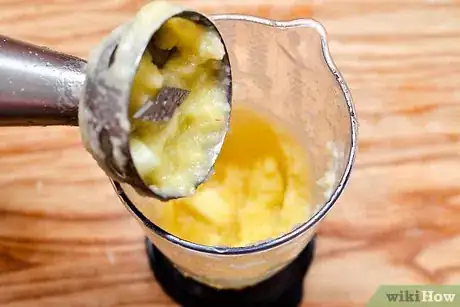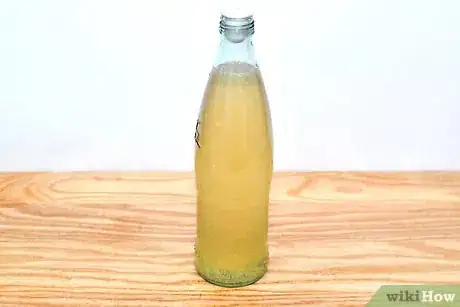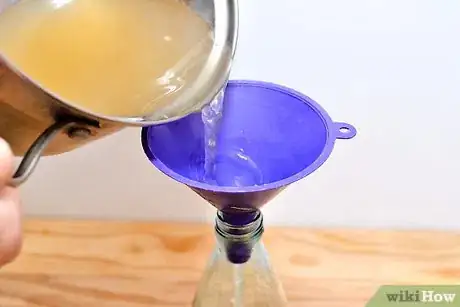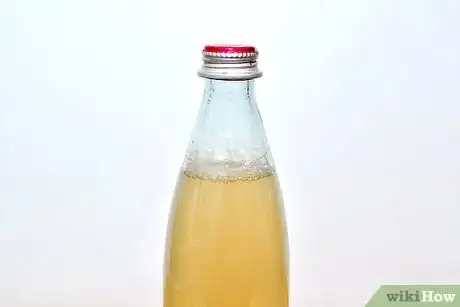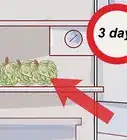This article was co-authored by Ollie George Cigliano. Ollie George Cigliano is a Private Chef, Food Educator, and Owner of Ollie George Cooks, based in Long Beach, California. With over 20 years of experience, she specializes in utilizing fresh, fun ingredients and mixing traditional and innovative cooking techniques. Ollie George holds a BA in Comparative Literature from The University of California, Berkeley, and a Nutrition and Healthy Living Certificate from eCornell University.
There are 7 references cited in this article, which can be found at the bottom of the page.
This article has been viewed 137,439 times.
The result of fermented apple juice is cider, which requires the natural yeast in apples to be present for the fermentation process. Cider is simply fresh pressed apples but cider takes on different meanings depending on where you are in the world. For Americans, cider is a sweet, non-alcoholic apple juice enjoyed during the fall and winter months but for many other countries, cider is a fermented alcoholic apple juice drink. You can learn how to ferment apple juice at home to achieve sweet apple cider.
Steps
-
1Choose apples to use for making the fresh cider. You can use any type of apple and even use a combination of different apples. If you pick the apples right off the tree, let the apples age for 1 week.[1]
-
2Clean the apples under cool running water, washing them thoroughly.[2]Advertisement
-
3Core the apples and quarter them. Use an apple corer to make this process quicker and easier.[3]
-
4Place the apple quarters into a blender, food processor or food chopper and process until smooth.
-
5Put the apple pulp into a porous fabric bag, such as a muslin sack or jelly bag, and squeeze out the juice into a bowl. Pour the liquid into glass bottles using a funnel, for ease.
-
6Fill the bottles to just below the rim and use a cotton plug. A cotton plug will pop out if too much pressure builds during the fermentation process, whereas a regular cap could make the bottle explode. Pressure builds when the bubbles from the carbon dioxide in the apple juice rise to the top of the bottle.[4]
-
7Store the bottled juice at 72 degrees Fahrenheit (22 degrees Celsius) for 3 to 4 days. Sediment will begin to form on the bottom of the bottles as a result of the fermentation process.[5]
-
8Strain the cider with a plastic strainer to separate the liquid and sediment. Discard the sediment, as this is not palatable.
-
9Pasteurize the fresh cider to prevent food born illnesses by heating it to 160 to 170 degrees Fahrenheit (71 to 77 degrees Celsius) in a stainless steel pot. Skim the foam that forms on top due to the heat and discard.[6]
-
10Fill heated glass bottles with the pasteurized cider and refrigerate. Drink the fresh cider within a week.[7] Freeze the fresh cider in glass or plastic freezer containers for up to 1 year after cooling the liquid down in the refrigerator.
-
11Finished.
Community Q&A
-
QuestionHow do I consume fermented fermented apple cider without heating to avoid destroying live enzymes?
 Community AnswerYou can add some to water with some honey and mix well. It makes a great morning tonic.
Community AnswerYou can add some to water with some honey and mix well. It makes a great morning tonic. -
QuestionI had a jug of apple cider that became fermented. Is there a way of reversing that process so that the alcohol is gone from it?
 Community AnswerNo, unfortunately you cannot reverse the fermentation process.
Community AnswerNo, unfortunately you cannot reverse the fermentation process. -
QuestionIs the finished product alcoholic?
 Community AnswerYes, it is. Fermentation is a metabolic process that converts sugar into acids, gases or alcohols. It occurs in yeast and bacteria, and also in oxygen-starved muscle cells, as in the case of lactic acid fermentation. Fermentation is also used more broadly to refer to the bulk growth of microorganisms on a growth medium, often with the goal of producing a specific chemical product.
Community AnswerYes, it is. Fermentation is a metabolic process that converts sugar into acids, gases or alcohols. It occurs in yeast and bacteria, and also in oxygen-starved muscle cells, as in the case of lactic acid fermentation. Fermentation is also used more broadly to refer to the bulk growth of microorganisms on a growth medium, often with the goal of producing a specific chemical product.
Warnings
- Do not use bruised or spoiled parts of apples, which will cause the juice to ferment too fast, or under ripe apples, which will leave the cider tasting flat.⧼thumbs_response⧽
- Do not use apples that have fallen from the tree, if you are picking fresh apples.⧼thumbs_response⧽
- Do not store cider in aluminum, iron or copper, as the cider will react negatively with these metals.[8]⧼thumbs_response⧽
Things You'll Need
- Apples
- Apple Corer
- Blender
- Porous Fabric Bag
- Glass Bottles
- Cotton Stoppers
- Funnel
- Strainer
- Stainless Steel Pot
References
- ↑ https://pickyourown.org/applepicking.htm
- ↑ https://www.foodandwine.com/how/wash-apple-best-cleanest-safest
- ↑ https://www.cooksillustrated.com/articles/1205-how-to-core-and-peel-apples
- ↑ https://nchfp.uga.edu/publications/uga/makingapplecider_uga.pdf
- ↑ https://www.motherearthnews.com/real-food/fermenting/how-to-make-hard-cider-zmaz07onzgoe
- ↑ https://nchfp.uga.edu/publications/uga/makingapplecider_uga.pdf
- ↑ https://extension.oregonstate.edu/sites/default/files/documents/8836/sp50455preservingfruitjuicesapplecider.pdf
- ↑ https://extension.oregonstate.edu/sites/default/files/documents/8836/sp50455preservingfruitjuicesapplecider.pdf
- https://pickyourown.org/applecider.htm

